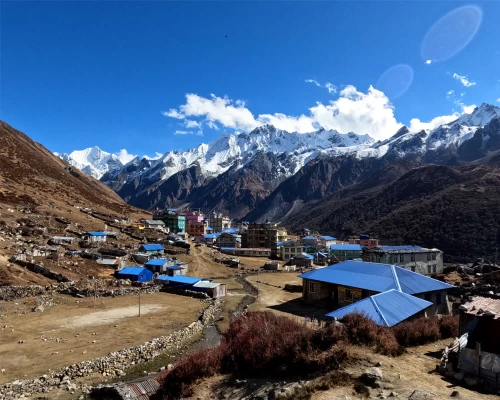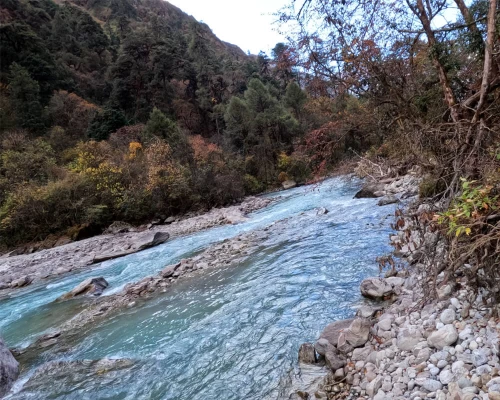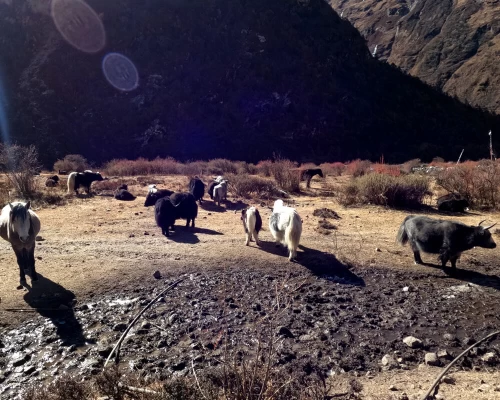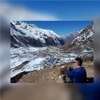"Langtang Gosaikunda Helambu trek is like stepping into a realm of natural wonders and cultural richness. From the rugged valleys of Langtang to the sacred Gosaikunda Lake and the pristine beauty of the Helambu region, this trek offers an exhilarating journey through breathtaking landscapes, diverse terrains, and encounters with friendly locals. Be prepared to immerse yourself in the serenity of nature, witness majestic mountain vistas, explore ancient monasteries, and indulge in the unique blend of Sherpa and Tamang cultures."
The Langtang, Gosaikunda, and Helambu trek is an exceptional combination of natural beauty, spiritual significance, and cultural richness. This trek allows you to explore the remote and splendid Langtang valley, visit the sacred Gosaikunda lake, and experience the vibrant culture of the Helambu valley. The trek is also known as the Langtang circuit trek and is located on the north side of the Kathmandu valley, near the Tibetan border.
Starting from Kathmandu, the trek offers convenient access and can be completed in around 15 days. Despite its proximity to the capital, the trail takes you to remote and isolated areas, providing a sense of tranquility and seclusion that is unique compared to more popular treks like the Everest Base Camp orAnnapurna Base Camp treks.
The major highlights of the Langtang, Gosaikunda, and Helambu trek include the enchanting Langtang National Park, which is home to diverse flora and fauna, including rare species like the red panda. The picturesque Langtang valley, with its breathtaking landscapes and traditional Tibetan-influenced villages, is another major attraction.
Kyanjin Gompa (3,865 m/12,675 ft), a sacred Buddhist monastery, and Tserko Ri (4,350 m/14,275 ft), a viewpoint offering panoramic mountain vistas, are also key highlights of the Langtang Helambu trek. The Langtang trek begins along the banks of the Bhote Kosi river, where you'll be captivated by its beauty and the soothing sound of rushing water.
As you make your way through the Langtang valley, you'll be surrounded by towering mountains, including the Langtang Lirung (7,234 m/23,734 ft), Shishapangma (8,027 m/26,335 ft), Ganesh Himal (7,422 m/24,350 ft), Dorje Lakpa (6,966 m/22,854 ft), Gangchempo (6,378 m/20,925 ft), and many others, which dominate the skyline with their majestic presence.
The trail will lead you through lush forests teeming with rhododendron, oak, and bamboo, creating a vibrant and enchanting atmosphere. You'll have the opportunity to spot various wildlife species, including the elusive red panda and a wide array of birdlife.
Throughout the trek, you'll have the chance to rest and rejuvenate in traditional Nepali guest houses. These guest houses provide comfortable accommodations and delicious meals, allowing you to immerse yourself in the local culture and hospitality.
The home of Lord Shiva- Gosaikunda Lake
Gosaikunda Lake (4,380 m/14,620 ft) holds great significance as a sacred pilgrimage site for both Hindu and Buddhist devotees. It is revered for its spiritual aura and is believed to have a black rock in its center, which is considered to be the head of Lord Shiva.
According to ancient legends, the creation of Gosaikunda Lake is attributed to Lord Shiva himself. The story goes that when Lord Shiva consumed the poison from the churning of the oceans to save the world, he felt an intense thirst. To quench his thirst, he struck a glacier with his trishul (trident), creating the pristine Gosaikunda Lake. The glacier meltwater is believed to be the purest and holiest water, carrying divine blessings.
The religious significance of Gosaikunda Lake draws devotees from far and wide, particularly during the full moon of August. This auspicious time sees thousands of pilgrims undertaking a journey to this sacred site. Pilgrims come to worship, seek blessings, and take holy dips in the pristine waters of the lake, believing that it purifies their sins and brings them closer to divine grace.
Beyond Gosaikunda Lake
As you continue your trek beyond Gosaikunda Lake, the path will lead you to an exciting adventure of crossing Laurebina pass (4,610 m/15,115 ft) and continuing towards the picturesque Helambu Valley.
The journey across Laurebina Pass will reward you with breathtaking views of the majestic Himalayas. The towering peaks and snow-capped mountains that surround you create a mesmerizing panorama, offering a sense of awe and wonder at the grandeur of nature.
The Helambu trail, which lies ahead, is a hidden gem waiting to be discovered. Often overlooked by many trekkers, it remains relatively untouched and unexplored, preserving its pristine beauty and serene atmosphere. The trail unveils a unique charm and allure, showcasing the raw and untouched landscapes of the region.
The inhabitants of the Helambu Valley are known as Hyolmo. They have their distinct language, culture, and traditions that set them apart from other communities. Interacting with the Hyolmo community in Helambu offers a fascinating opportunity to immerse yourself in their rich heritage and experience their warm hospitality.
Langtang Gosaikunda Helambu trek difficulty & altitude sickness
The Langtang Gosaikunda Helambu trek is a moderately challenging trek that takes you through diverse landscapes, including lush forests, high alpine meadows, and picturesque valleys. While it may not be as strenuous as some of the more demanding treks in Nepal, it still requires a reasonable level of fitness and preparation.
The Langtang Gosaikunda Helambu trek generally involves daily walking for around 5-7 hours, covering an average distance of 10-15 kilometers per day. The trail includes both uphill and downhill sections, with steep ascents and descents.
While prior trekking experience is not mandatory, it is beneficial to have some level of hiking experience and physical fitness. Regular cardiovascular exercises, like walking, jogging, or cycling, can help prepare your body for the trek.
Our Langtang Gosaikunda Helambu trek itinerary includes acclimatization days at strategic points, such as Kyanjin Gompa and Gosaikunda. These rest days allow your body to adjust to the altitude and reduce the risk of altitude-related illnesses.
Altitude sickness can affect trekkers when ascending to higher altitudes too quickly. Symptoms of AMS include headache, nausea, dizziness, loss of appetite, and fatigue. Be aware of the signs and take necessary precautions.
Staying hydrated is crucial at higher altitudes. Drink plenty of fluids, preferably water, and avoid alcohol and caffeine. Trekking at a steady and moderate pace helps your body adjust to the altitude more effectively.
*Note: Remember, everyone's response to altitude can vary, regardless of fitness level or previous trekking experience. It's essential to listen to your body, communicate any discomfort to your guide, and follow their advice for a safe and enjoyable trek.
Langtang Gosaikunda Helambu trek preparation
Engage in regular cardiovascular exercises like walking, jogging, cycling, or swimming to improve your stamina and endurance. Aim for at least 30 minutes of exercise three to four times a week. Strengthen your leg muscles and core through exercises such as squats, lunges, and planks. Building strength will help you tackle challenging terrain and carry your backpack comfortably.
Learn about the trek, its challenges, and the region's culture. This will help you mentally prepare for the journey and set realistic expectations. Develop a positive attitude and mental resilience to overcome any obstacles or discomfort you may encounter during the trek. Keep in mind that trekking can be physically demanding, but the rewards are worth it.
Langtang Gosaikunda Helambu trek elevation and altitude profile
The trek starts at a relatively low altitude (1,503 m/4,655 ft) and gradually gains elevation. The highest point reached during the trek is Laurebina Pass, at 4,610 meters (15,115 ft). You will touch two other significant high altitudes during the trek. One at Gosaikunda lake (4,380 m/14,620 ft) and the other at Tserko Ri (4,350 m/14,275 ft). The total gain in elevation from the starting point is 3,107 meters (9,965 ft).
Alternative adventurous treks in Nepal
First of all, you can do the Langtang valley trek and Gosaikunda lake trek separately with us if you are short on time. Here are some other trekking packages in Nepal that are challenging and offbeat:Everest Gokyo lake trek, Manaslu circuit trek, Everest three high passes trek, Kanchenjunga circuit trek, Nar Phu valley trek, etc.
Travelers with a short time can customize any trekking packages with us. These are some of our famous short treks in Nepal: the Ghorepani Poon Hill trek, Chisapani Nagarkot trek, Mardi Himal trek, Mohare Danda trek, Everest View trek, and Pikey Peak trek.
The benefit of Langtang Gosaikunda Helambu trek with Nature Excursion
We offer the best Langtang Gosaikunda and Helambu trek in the market. Our package covers all the necessities at a comprehensive price and is easy to customize. Apart from our genuine trek cost and attention to detail, you will get native guides and porters for the journey. We will book you the best guesthouse and help you prepare for the trek. From the moment you book a trek with us, our team will be there to assist you with all your questions.
Below are some of the perks of trekking with us at Nature Excursion in Nepal:
- free airport pick-up and drop-off service
- complimentary welcome and farewell dinner
- duffel bag and first aid kit to use during the trek
- free company t-shirt and trek certificate
- no hidden costs and full transparency
- eco-friendly and sustainable treks
- 24/7 support and 100% guaranteed departure








-(1).webp)



.webp)